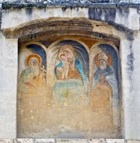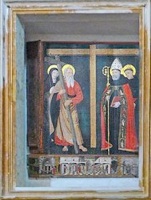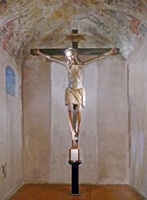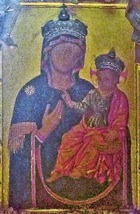

Pancrazio Jacovetti
Pancrazio Jacovetti da Calvi was documented in 1467 as “pictor” (painter) in his native town, some 20 km south of Narni. Subsequent records show him as an active citizen of the town. His only securely attributed works are the signed frescoes in San Biagio, Corchiano, which were probably painted soon after the church was rebuilt in 1466. These reveal him to have been a follower of Antoniazzo Romano.
He probably died before 1513, the year in which his three sons sold some land that had belonged to the family.
Narni
A surviving document records that the Priors of Narni paid Pancrazio Jacovetti da Calvi for three images (presumably frescoes) of the arms of Pope Sixtus IV in 1472.
Madonna and Child with saints (15th century)

Standing saints (15th century)


Panel in Sant’ Agostino Crucifix, now in San Giovenale
This panel in Sant’ Agostino (a niche on the right, near the counter-facade) is attributed to Pancrazio Jacovetti da Calvi. It depicts a large wooden cross with pairs of standing saints to either side:
-
✴SS Monica and Andrew (the original titular of the church), on the left; and
-
✴SS Augustine and Nicholas of Tolentino, on the right.
The panel apparently originally formed the backdrop for a Crucifix (15th century) that is now in San Giovenale, which is illustrated here. The cross and plain background of the panel were painted in at an unknown time over the original landscape setting.

The predella, which might be by another artist, depicts:
-
✴the martyrdom of St Andrew;
-
✴the flagellation and the road to Calvary in an architectural setting (illustrated above); and
-
✴the Mass of St Augustine.
Madonna della Consolazione (15th century)

Rinaldo Jacovetti
Rinaldo da Calvi, the son of Pancrazio, was documented in 1497 as “magister” (master) in Calvi. He trained in his father’s workshop, which he probably continued after his father’s death. His only known, signed work is a documented altarpiece (1521) of the Coronation of the Virgin in San Nicolò, Stroncone. His documented frescoes (1525) in the church of Sant’ Antonio Abate, Civita Castellana also survive. A document in Calvi dated 1528 refers to him as deceased.
Narni
In 1514, Bishop Pietro Gormaz commissioned from Rinaldo the decoration and gilding of the Cappella della Consolazione in San Giovenale. Most of this work has been lost.
In 1522, the Priors asked him to value an unspecified work by Lorenzo Torresani.
In 1523, he received a commission from Cardolo dei Cardoli, the Prior of the Società delle Suore del Rosario, for a now-lost altarpiece of the Assumption of the Virgin, surrounded by scenes of the mystery of the Rosary, for Santa Maria Maggiore (now San Domenico).



